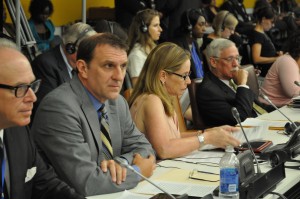by Joseph. P. Tartaro

Among those voicing concerns at the UN Programme of Action meeting in New York on Aug. 29 were, left to right: Allen Youngman (DSAAC), Rick Patterson (SAAMI), Julianne Versnel (SAF, IAPCAR), and Tom Mason (WFSA).
Executive Editor
In late August, an umbrella organization of 23 separate United Nations (UN) agencies known as the Coordinating Action on Small Arms (CASA) adopted the first portion of International Small Arms Control Standards (ISACS). The ISACS text is made up of 33 separate modules, some 800 pages in total. So far, eight modules have been adopted as the result of a process begun in the spring.
An Experts Reference Group (ERG), which included a small number of professionals with firearms experience, including Richard Patterson, managing director of the Sporting Arms and Ammunition Manufacturers Institute (SAAMI), provided constructive criticisms on the first draft text of these modules.
A second draft, however, revealed that numerous issues identified by the ERG had not been addressed; a fundamental violation of the legitimate standard-setting process.
In response, SAAMI prepared a detailed minority report that Patterson submitted to the ISACS project coordinator covering a range of these issues.
“Sadly, SAAMI is forced to conclude that ISACS has and will continue to fail in the creation of clear and effective guidance because of breaches in standards- setting protocols, and dogmatic adherence to unsubstantiated assumptions, agendas and biases,” Patterson said in a March statement before a UN committee working on the matter.
In another statement delivered at an Aug. 29 UN conference, Patterson described ISACS as “… nothing more than a platform for adoption and pseudo-legitimization of the ‘wish lists’ of special interest groups.” “Advocates of gun control make two fundamental assumptions: First, that more guns will equal more violence and, second, that more gun control will equal less violence. Both of these assumptions are confounded by history and by facts. They are simply not true.
Countries with high rates of gun ownership have low rates of violence and countries in which civilian ownership of guns is banned have high rates of violence. Ignoring these facts can cause harm by removing the means by which people protect themselves, their families and their communities—and thereby protect their rights to self-determination,” Patterson said.
Patterson was not the only one to speak against many of the protocols under consideration under the umbrella of the Programme of Action (PoA) launched in 2001. The Arms Trade Treaty (ATT), a binding agreement that included small arms and ammunition, was supposed to be adopted in July but failed when the United States, Russia, and several other countries did not agree to draft language. Rather than abandon the global gun control agenda, proponents of the ATT focused on moving forward incrementally under the PoA.
Others besides SAAMI speaking out at the UN in August against the planned implementation of global gun control under the PoA included representatives of the World Forum on the Future of the Shooting Sports (WSFA), Canada’s National Firearms Association (NFA), Second Amendment Foundation (SAF), and Defense Small Arms Advisory Council (DSAAC).
SAF’s Director of Operations Julianne Versnel, reminded the UN that “if women have the right to be protected against violence, then they have the right to protect themselves against violence.” Supporters of the global gun control agenda have been trying to play the “women’s rights” card, but Versnel’s remarks were unlike anything many delegates at the UN had ever heard before.
Noting that she had reviewed what had already been written and said about the violence against women as it relates to the Programme of Action, Versnel emphasized that, “I am struck by what is not said.” “If there is a basic sanctity of a woman’s person,” she observed, “if there is a right to not be a victim of sexual or personal violence, then that right involves the right to defend one’s self.” Versnel stressed that any new global gun control initiatives must “do nothing to disarm women who legitimately and rightfully want to defend themselves.” Perhaps Versnel’s warnings may open up a new and politically uncomfortable arena for the prohibitionists.
“The drive for human rights is a force throughout the world,” Versnel stated, “and especially here at the UN. A woman’s right to be free from violence is a fundamental human right. That fundamental right is to defend one’s self. The report of this conference should state that without reservation.” Canada’s NFA was the only Canadian pro-firearms group represented during the non-governmental organization presentations at the Second Review Conference of the PoA.
NFA President Sheldon Clare told TGM, “It was important for the NFA to be present at this conference for four main reasons. First, the PoA is alive and potentially dangerous—this was a well-attended conference and vigilance is critical. Second, it was necessary for us to make sure that there was no attempt to make this the Arms Trade Treaty consolation round, or in any way broaden the scope of the PoA. Third, we needed to make our concerns known about the aims of some to include firearms components and ammunition, and to make it clear that we are speaking out strongly in support of civilian rights of self-defense—the only Canadian organization to do so. The fourth reason we were there was to use our strong voice to support our friends.” According to Clare, “The government (Canada) seems to be headed in the right direction. I was pleased to hear the concise and clear presentation by Senior Policy Advisor Kim Joslin of the Canadian Delegation which was in strong support of firearms owners. In particular, Canada supported the US position which opposes including any aspect of components or ammunition being included in the PoA.”



